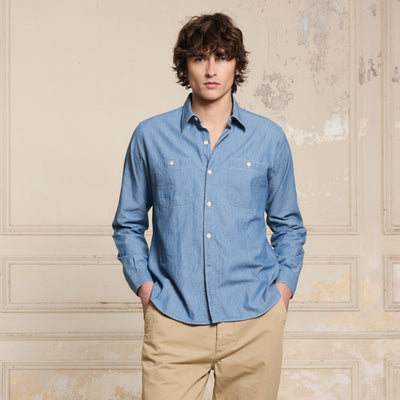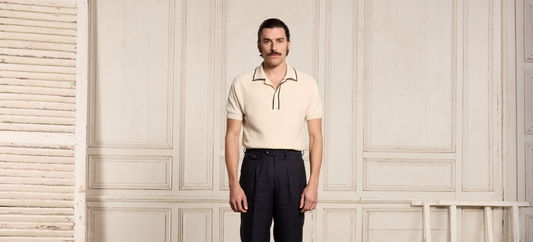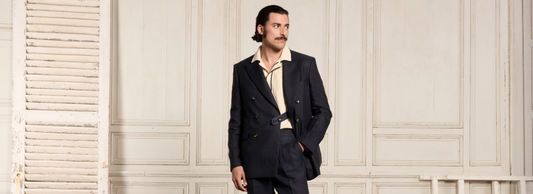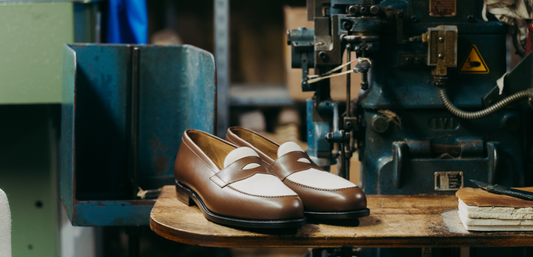In the kingdom of legendary fabrics, denim and chambray are kings. For Hast, whose quest for the finest materials has continued since 2012, these two fabrics are among the richest there are. Often lumped together because of their appearance, they nevertheless have their own stories and characteristics. Today, we offer you an article in the form of a tribute, to the glory of this armor that is impervious to the passage of time.
Common origins
With all the necessary precautions, it seems reasonable to us to see in chambray and denim two descendants of medieval “fustaine”. In the Middle Ages, this canvas or twill type fabric generally used a cotton warp and a linen, wool or silk weft. Moreover, this is precisely what will subsequently distinguish the two iconic fabrics in which we are interested.
Before going any further, a little technical reminder is in order.
To make a fabric, horizontal (weft) and vertical (warp) threads must be interwoven . To do this, three main techniques coexist, which offer different properties:
- the plain weave consists of a regular crisscrossing of the threads. The weft thread passes alternately over then under a warp thread (and vice versa), which gives a fabric with a harmonious appearance, identical on the wrong side and on the right side. This is the simplest and oldest armor.
- the twill weave is more uneven since it displays oblique ribs. These diagonals are due to a particular weaving method, where the weft passes under a warp thread then over several others. This weave provides, de facto, more texture and relief.
- satin weave , for its part, is more complex and less widespread on the market. Here, the crossing points between warp and weft are distributed more or less randomly, until they become imperceptible. The expected objective is that of a smooth and flat surface, often silky on the front and matte on the reverse.

Credits: Louise Magazine
In association with the raw material and the diameter of the threads used, these different techniques have an influence on the openness, density, flexibility and resistance of the fabric.
Coming back to chambray and denim, this is the fundamental difference between these two fabrics so frequently confused: the first is a canvas while the second is a twill.
The amazing history of chambray
Taking its name from the French commune of Cambrai (in present-day Hauts-de-France) where it was invented during the 16th century, chambray is a plain weave historically woven with linen threads . Fine and luxurious, “cambric” – to call it by its period name – is already used to make shirts , but also underwear . In the following century, the British Empire massively imported Indian cotton, a softer and less expensive material. Made in cotton, the “ scotch chambric ” from across the Channel then competes with the “ French cambric ” dressed entirely in linen. Too expensive, the second will gradually disappear and leave its English counterpart with a monopoly on chambray . In the United States, this light and robust fabric quickly attracted farmers and the working class. Crafted with an indigo warp and an ecru weft , its bluish color will inspire the term “ blue collars ” to designate manual workers, as opposed to white collars. Over time, chambray will accompany cowboys, US Navy sailors, movie stars and lovers of beautiful materials.
The incredible journey of denim
More recent without being very new, denim is a twill fabric whose origin frequently animates debates. Some associate it with “ Nîmes serge ”, a fabric made of wool and silk in Languedoc in the 18th century, whose distorted name would have given rise to “ denim ”. Others rather see a lineage dating back to the heyday of Italian exports. Before the British Empire flooded the market with Indian cotton, it was in fact the port of Genoa which supplied the main European cities with mixed cotton, wool and linen fustians . In the registers of the port of London, a distortion of the name of this Ligurian town would thus have given history the word “ jean ”. Denim, for its part, would be an emanation of these Genoa fustians, worked in cotton twill for the sake of economy and diversification. As everyone knows, it was in the United States that denim would next experience its heyday: since the establishment of the cotton industry at the end of the 18th century , denim was one of the first fabrics produced on a large scale. The idea of dyeing the warp with indigo to give it its famous blue hue , coupled with the various innovations of a certain Levi Strauss, completed its entry into the pantheon of legendary fabrics.
Hast and the interpretation of complementary subjects
Frequently confused, chambray and denim have many points in common: invented in Western Europe, they have crossed the centuries (and the Atlantic) before conquering the world thanks to unique properties , absolute versatility , a singular texture and a color recognizable among thousands .
However, their differences speak for themselves and make them more complementary than similar fabrics. In fact, denim is a sturdy and rustic twill , more suitable for pants , jackets and thick shirts . For its part, the finesse and flexibility of chambray flourishes much better on a shirt .
Capitalizing on their respective characteristics, we have obviously taken care to use these materials in the appropriate registers when thinking about our collections. As a result, you will find on our racks:
- denim pants : from indigo selvedge jeans to our ecru 5-pocket pants and a cleverly faded blue model , you're sure to find what you're looking for to dress your legs in the most famous twill fabric. With its inimitable diagonals, its unfailing robustness and its unparalleled versatility, you just have to choose yours to take on 500 years of history.
- denim shirts : first used for the manufacture of work pants, denim has gained height to bring its science to bust pieces. Unbreakable and resolutely workwear, our denim shirts exude the Great West, freedom, tradition and authenticity. Woven in Italy from very fine yarns, you will be able to choose your favorite wash from our raw , dark , light or officer collar models. On the occasion of our 10th anniversary, we even imagined a limited edition model , a barely veiled homage to the now famous “western shirt” of North American cowherd boys. With its shoulder yokes, its two chest pockets and its snap buttons, it almost makes you want to stroll with a blade of grass in the corner of your lips, or to treat yourself to a pair of cowboy boots.
- chambray shirts : composed of a white weft thread and an often dyed warp thread, our chambray shirts are immediately recognizable by their supple and creamy texture. Woven in a plain weave, they are identical on the front and back, with this subtly mottled blue color. Light and full of character, they combine texture and uniformity like no other. At Hast, we offer it in light blue and dark blue , but also in a more pronounced workwear register , weighted down with its historic patch pockets.
It's your turn to tame these legendary fabrics

At first glance, taming fabrics that are half a millennium old can be quite intimidating. However, you will quickly see that they are just waiting to enhance the smallest of your outfits , whatever the style. As you probably suspect, it is not for nothing that they have attracted almost all professions on all continents over the last five centuries: from the clergy to the military, including gold prospectors, workers, cows -boys, craftsmen, artists or designers, their versatility no longer needs to be demonstrated .
Denim and chambray are like that: they can be worn from head to toe, together or separately, in a total look or to create a break in a dressy outfit, à la Gainsbourg... or à la Hast.

And now it's your turn.













